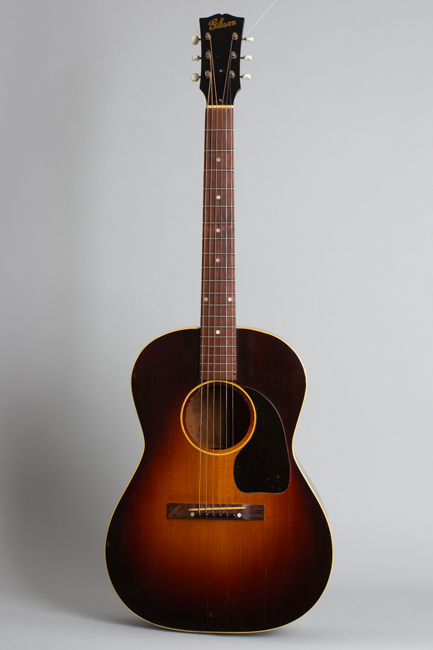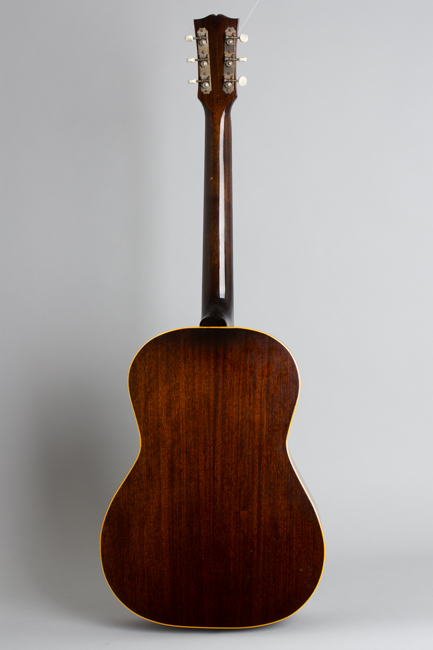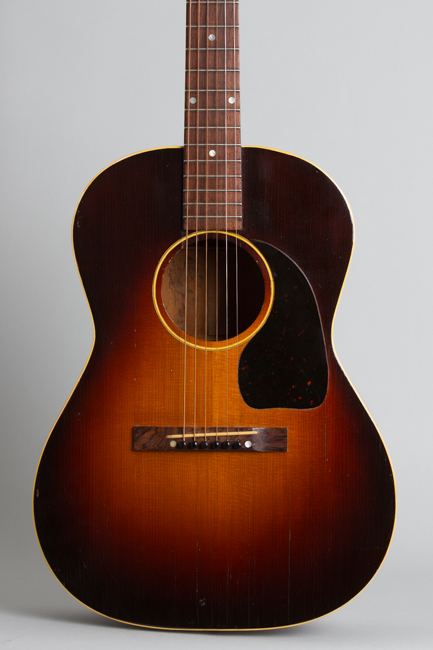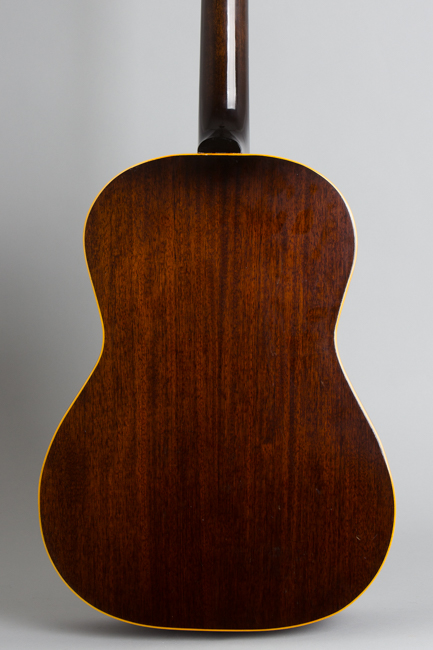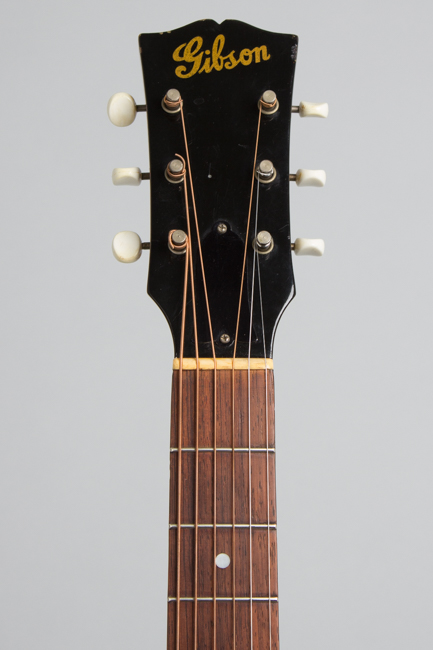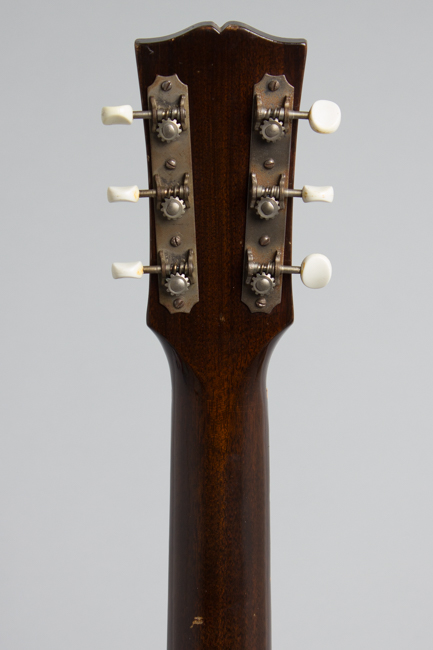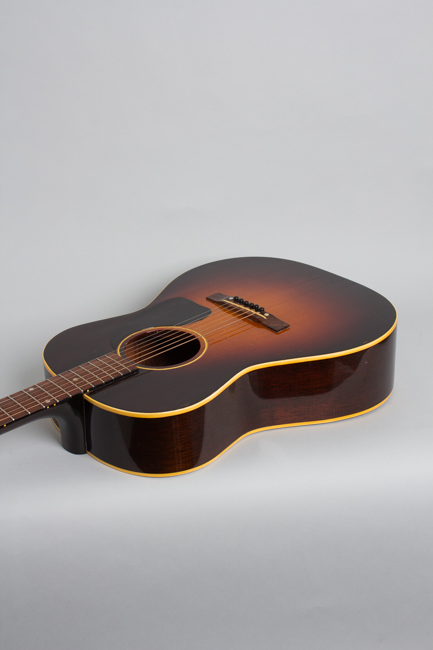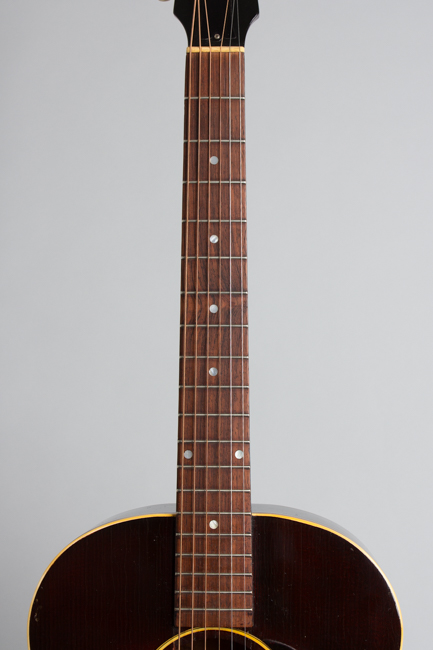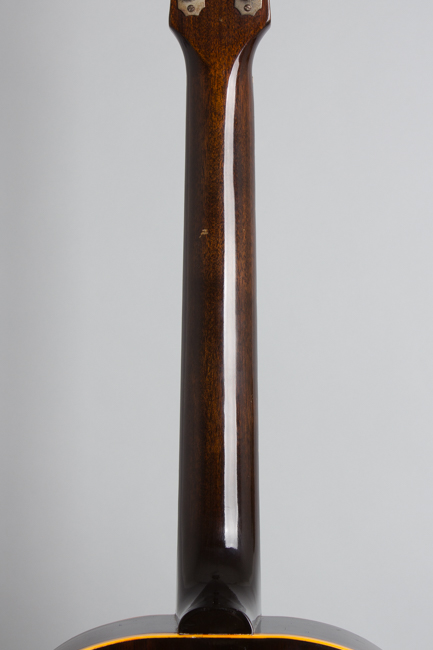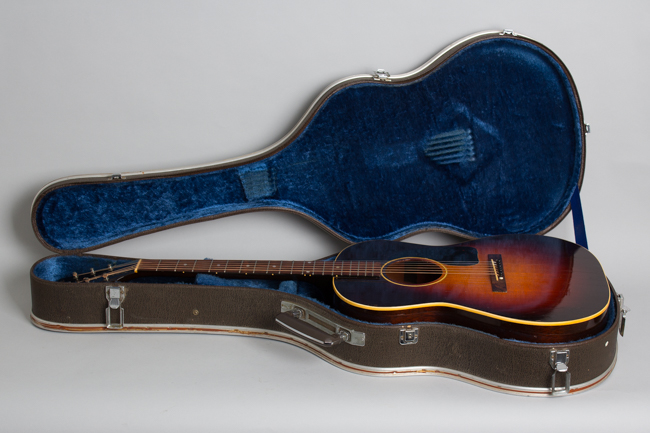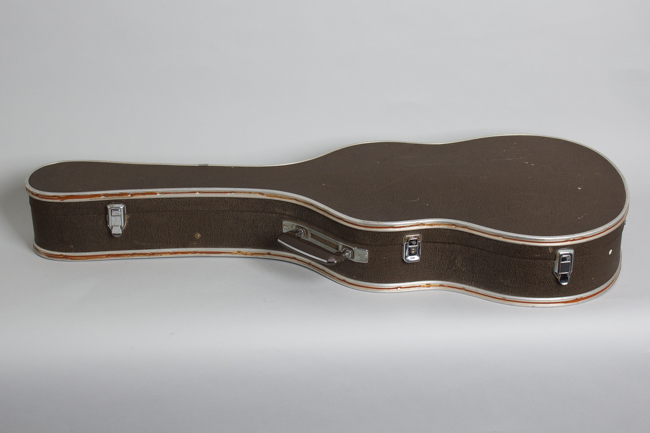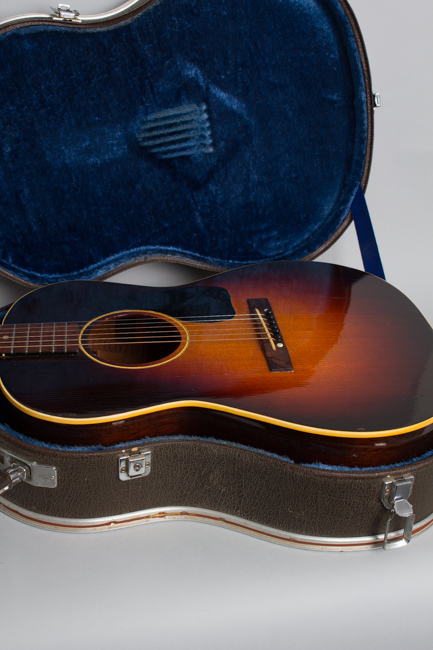Gibson LG-2 Flat Top Acoustic Guitar (1946-7)
This item is currently on hold.
Item # 12720
Prices subject to change without notice.
Gibson LG-2 Model Flat Top Acoustic Guitar (1946-7), made in Kalamazoo, Michigan, sunburst top, dark stained back and sides finish, mahogany back, sides and neck, spruce top, rosewood fingerboard, hard shell case.
This just post-WWII LG-2 shows only minimal play wear but does have visible repairs to the top from what must have been some very dry storage over the last 75 or so years. The LG-2 was Gibson's most popular smaller body flat-top guitar model from the 1940s and '50s, the middle model of a three-instrument line with the externally identical but ladder-braced LG-1 below it and the natural-finish LG-3 above. Exact production figures from this period are lost, but in 1948-50 the LG-2 sold roughly 1000 instruments a year, with more than double that amount of LG-1's shipped. These first post-war ones like this are somewhat scarcer than later examples, suggesting they were built in smaller numbers as Gibson was just getting back up to speed after doing mostly war work for 4 years.
For some reason lost in Gibson history these 1946-48 flat tops have no serial or factory order numbers, so can only be dated by the features. This one appears to be a fairly early example bearing the old gold script logo that disappeared by 1948. Other typical features include a beautifully shaded darker sunburst top finish, dark mahogany back and sides, small tortoise celluloid pickguard, small rectangle bridge and single binding on the top and back. The headstock is tapered in depth, still with WWII pattern riveted-gear Kluson tuners fitted. The truss-rod equipped neck has a lovely round-backed "C" profile, quite comfortable if substantial feeling, not as deep as the thick wartime "baseball bat" style. This is a smooth sounding and versatile guitar; brighter than some when pushed but never thin, generally a fine example of Gibson's early post-war flat-top period.
Overall length is 39 1/2 in. (100.3 cm.), 14 3/8 in. (36.5 cm.) wide at lower bout, and 4 1/2 in. (11.4 cm.) in depth at side, taken at the end block. Scale length is 24 3/4 in. (629 mm.). Width of nut is 1 11/16 in. (43 mm.).
This is a very nice example, showing some small wear spots overall but not appearing to have had too much play time since before the Korean War! The original lacquer is still shiny maintaining the original strong color to the sunburst, with some typical checking and a very nice original patina overall. There is really not much notable wear, just small dings, scuffs, and other minor marks. The back of the neck is clean with one feelable dink behind the third fret.
The visible repairs are all to the top, which must have gotten very dry at some point. There are a number of old tight spruce grain splits running from the bridge to the back edge, with smaller ones off the lower edges of the fingerboard extension and along the top and bottom edges of the pickguard. All of these have been solidly sealed with some nicely done internal cleating and some minor touch up but are visible; there was no wholesale finish work or overspray. There are no other cracks on the rest of instrument.
The neck has never been reset; the original bridge has probably been lowered slightly with the original saddle taken down, the original small maple bridgeplate and retaining bolts are still fully intact. The original tuners have been neatly re-buttoned. There has never even been a strap button added. This is an really excellent playing and sounding instrument, quite powerful sounding for a smaller-bodied guitar and despite the repairs to the top generally better preserved than most from the 1940s. Overall Excellent - Condition.
This just post-WWII LG-2 shows only minimal play wear but does have visible repairs to the top from what must have been some very dry storage over the last 75 or so years. The LG-2 was Gibson's most popular smaller body flat-top guitar model from the 1940s and '50s, the middle model of a three-instrument line with the externally identical but ladder-braced LG-1 below it and the natural-finish LG-3 above. Exact production figures from this period are lost, but in 1948-50 the LG-2 sold roughly 1000 instruments a year, with more than double that amount of LG-1's shipped. These first post-war ones like this are somewhat scarcer than later examples, suggesting they were built in smaller numbers as Gibson was just getting back up to speed after doing mostly war work for 4 years.
For some reason lost in Gibson history these 1946-48 flat tops have no serial or factory order numbers, so can only be dated by the features. This one appears to be a fairly early example bearing the old gold script logo that disappeared by 1948. Other typical features include a beautifully shaded darker sunburst top finish, dark mahogany back and sides, small tortoise celluloid pickguard, small rectangle bridge and single binding on the top and back. The headstock is tapered in depth, still with WWII pattern riveted-gear Kluson tuners fitted. The truss-rod equipped neck has a lovely round-backed "C" profile, quite comfortable if substantial feeling, not as deep as the thick wartime "baseball bat" style. This is a smooth sounding and versatile guitar; brighter than some when pushed but never thin, generally a fine example of Gibson's early post-war flat-top period.
Overall length is 39 1/2 in. (100.3 cm.), 14 3/8 in. (36.5 cm.) wide at lower bout, and 4 1/2 in. (11.4 cm.) in depth at side, taken at the end block. Scale length is 24 3/4 in. (629 mm.). Width of nut is 1 11/16 in. (43 mm.).
This is a very nice example, showing some small wear spots overall but not appearing to have had too much play time since before the Korean War! The original lacquer is still shiny maintaining the original strong color to the sunburst, with some typical checking and a very nice original patina overall. There is really not much notable wear, just small dings, scuffs, and other minor marks. The back of the neck is clean with one feelable dink behind the third fret.
The visible repairs are all to the top, which must have gotten very dry at some point. There are a number of old tight spruce grain splits running from the bridge to the back edge, with smaller ones off the lower edges of the fingerboard extension and along the top and bottom edges of the pickguard. All of these have been solidly sealed with some nicely done internal cleating and some minor touch up but are visible; there was no wholesale finish work or overspray. There are no other cracks on the rest of instrument.
The neck has never been reset; the original bridge has probably been lowered slightly with the original saddle taken down, the original small maple bridgeplate and retaining bolts are still fully intact. The original tuners have been neatly re-buttoned. There has never even been a strap button added. This is an really excellent playing and sounding instrument, quite powerful sounding for a smaller-bodied guitar and despite the repairs to the top generally better preserved than most from the 1940s. Overall Excellent - Condition.
